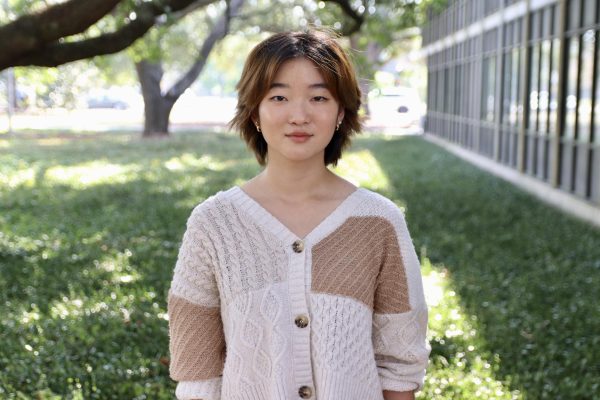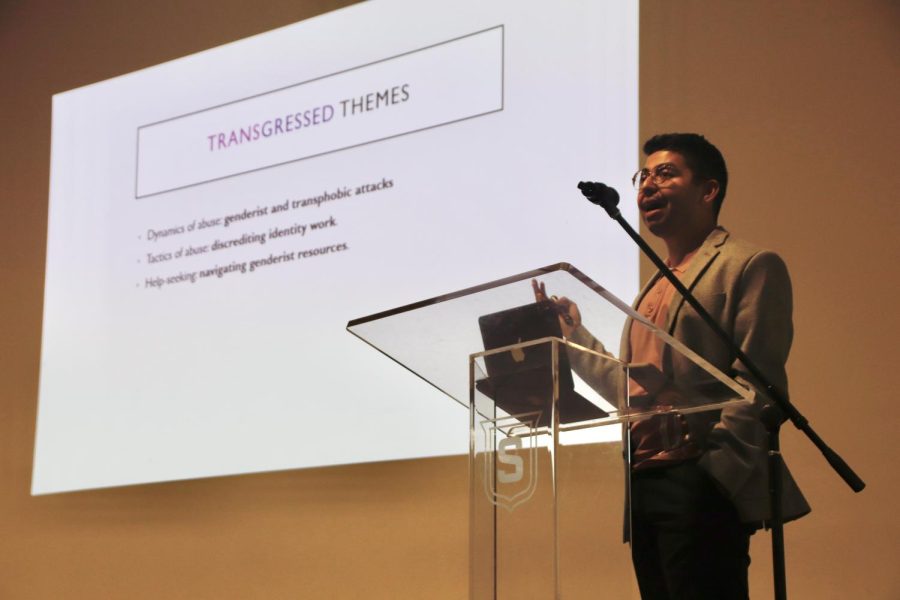Lecture delves into intimate partner violence against transpeople
Dr. Xavier L. Guadalupe-Diaz speaking on transgender intimate partner violence in the United States on the Student Union Theater stage.
Trigger Warning: Includes accounts of intimate partner violence and sexual, physical and emotional abuse.
Dr. Xavier L. Guadalupe-Diaz, associate professor of sociology at Framingham State University and author of “Transgressed: Intimate partner violence in transgender lives,” shared his research on IPV and sexual violence in a lecture hosted by the Sociology and Criminal Justice Department on March 29 in the Student Union Theater. According to Guadalupe-Diaz, recent studies have shown a higher rate of intimate partner violence (IPV) in transgender populations.
He stated, “The project [“Transgressed”] was born out of the big gap in the literature where we would routinely see trans people dropped out of the sample either because they were too small or that there weren’t any concerted target efforts to really get this information.”
Guadalupe-Diaz noted IPV includes physical, sexual, emotional, financial and psychological abuse in current or former romantic relationships.
Cisgendered describes those whose sex assigned at birth aligns with their gender identity. Cisnormativity describes the social and cultural environment that only acknowledges two sexes and emphasizes a hierarchy that prioritizes men over women and girls.
Guadalupe-Diaz referenced the “2015 U.S. Transgender Survey” (USTS) published by the National Center for Transgender Equality (NCTE).
The data showed high rates of IPV against transpeople. Over half reported some form of partner violence. About a third reported physical violence and a quarter experienced severe forms of violence; both rates are slightly higher than the general population.
He showed the Black, Indigenous, Latinx and Asian population rates of violence recorded in the survey. Indigenous populations had the highest rates of violence in the IPV, sexual assault and violence in the family origin categories.
“This is something I see in cisgender samples as well. This shows marginalization of populations compounds risk factors for violence overall,” Guadlupe-Diaz explained.
Within trans populations, more marginalized identities and communities report more violence and higher rates of poly victimization, which describes the number of violent victimizations someone receives over a life course.
Guadalupe-Diaz shared how the context of the relationship and the identities involved influence how IPV develops.
Gender identities, racial identities and class status create different types of vulnerabilities. For transgender people of color, in particular Blacks and Latinos, disproportionate risk factors for violence were recorded.
Guadalupe-Diaz said it’s important to think about all the factors that facilitate pathways to vulnerability or increase the risk of partner violence.
He noted the media often frames transgender homicides as hate violence, but at least half are committed by former or current romantic, sexual or intimate partners.
Guadalupe-Diaz explained, “Why this matters is that we’re painting this broader context of where the abuse is happening and really getting a sense of all of the forms of violence that relate to higher risk factors overall.”
Other forms of violence studied included institutional and structural. These categories are comprised of the police, carceral state, the education system, public accommodations and economic marginalization.
The data showed higher rates of unemployment, poverty and housing insecurity for transgender people, which creates precarious, vulnerable situations.
He explained major themes in the accounts of violence, including genderistic transphobic attacks, discrediting of identity work and help-seeking. Out of the 19 relationships in the study, six of the abusers were transgender and still used genderistic and transphobic attacks.
“This is a little bit of a shake in IPV theory in general, where we see the focus mainly on who has more societal power, who has more privilege, they are more likely to be the abusers. While that may be true in a lot of samples, “Transgressed” gives us a sense that we kind of need to shake up that rigidity of how we understand power. That it’s not just something structural and how society is organized, but rather it seeps into our relationships into the micro level regardless of what you identify as and who you are,” he added.
Guadalupe-Diaz elaborated on the abusers’ destroying their victims’ identity work, where the abuser would negatively interfere with the victim’s efforts to express and accept their identity so the victim would feel reliant on the abuser.
“Identity work something we all do regardless of gender, but for trans people whose identities are regularly marginalized, attacked, identity work becomes a site of potential abuse,” Guadalupe-Diaz said.
The last theme in the study dealt with navigating genderist resources while leaving the relationship.
Shelters, the criminal legal system and human services, generally were not accepting of the participants.
Guadalupe-Diaz noted 100% of undocumented trans IPV survivors did not go to a shelter, which emphasizes the marginalization of migrants and the fear of seeking help from formal systems for fear of criminalization.
Due to the lack of structural help, they relied on friends, showing the importance of community, allies, neighbors and friends.
Guadalupe-Diaz shared his thoughts on the future of transgender IPV. He spoke on the survivors’ needs – housing, safety, stability and independence – and on creating different avenues in response to IPV that don’t rely on the criminal legal system.
“It’s important to think about juggling both of those priorities. Reducing harm that the system creates, but also thinking creatively about how we seek accountability and how we seek safety, security and independence without relying on problematic systems that haven’t traditionally worked for many IPV survivors,” Guadalupe-Diaz concluded.
Your donation will support The Lion's Roar student journalists at Southeastern Louisiana University.
In addition, your contribution will allow us to cover our annual website hosting costs.
No gift is too small.

Yumi Domangue is a double major in mechatronics engineering technology and new media and animation. She joined Student Publications in the Fall of 2021...






